
The Navy Department Library
Chapter X. Hit That Beach!
* * * * *
A high spot in the training of every man in "amphib" is his first mock landing attack. These maneuvers are very much like the real thing. The boats used are the same ones employed overseas and tanks and troops are carried, just as in a genuine attack. Demolition crews stationed on the shore help to provide a realistic setting by firing flares and exploding mines and bombs. Also, a heavy smoke screen is laid to blot out the beach as the first boat wave goes in. To give you a preview of what you will see and do in that first large-scale training maneuver, this chapter describes a mock landing attack at an amphibious training base.
Several times before the landing the officers and men who will take part are briefed. Briefing consists of a detailed explanation of the operation. The stations at sea, such as the transport area at which landing boats are loaded, are described. The beaches to be hit and occupied are identified. Directions are given and questions are answered. Every step of the operation has been worked out in advance down to the last detail. At the end of the session everyone should have a clear picture of their share in the work ahead.
In an actual assault on enemy-held shores the landing boats are lowered from transports on
--69--
D-day. Those boats which were rail-loaded before launching immediately shove off for the rendezvous area. This is a section of ocean in which craft assemble when ready for the run to the line of departure. A Control boat marks this position. It can be identified by the signal flag which it flies.
LCVP's and LCM's which were lowered over the side of their AKA or APA without cargo haul out to a designated assembly area near the transport and form assembly circles as directed. From these positions they are summoned alongside to debarkation stations to pick up troops, equipment, and supplies.
In training operations, landing boats usually take up the positions mentioned above. There they move in tight circles until called up for loading. Because many boats are near the transport they all move slowly, usually at steerageway, to avoid setting up wakes that might cause damage.
Let us assume that you, a trainee, are coxswain of an LCVP on the day of a mock landing attack. Some of the things you will see and do are described in the paragraphs below.
Early in the morning you and the other crew members leave the docks at your training base. In the gray light you fall in column formation with dozens of other landing craft and head out toward the transport to take position for loading. There you move in the circles mentioned in the preceding paragraph. At this stage in the game it is important for all coxswains to keep their boat in the correct place in the assembly areas. If the transport swings the coxswains change their positions so that the circles of boats are always in the same place relative to the transport.
At the same time, the signalman in your boat keeps a sharp watch for the signal which will call an LCVP alongside the transport. LCVP's and LCM's are called to debarkation stations by signals displayed aboard the ship*. As soon as these appear at a debarkation station the type of boat summoned leaves its circle and goes alongside. (The boat nearest the transport at the time of the signal is the one that peels off.) Assistant Boat Group Commanders are responsible for this phase of the operation. One of these officers is aboard a landing boat in your assembly area to see that circles are kept small, that proper speed, position, and distance are maintained, and that signals to come alongside are answered promptly.
Your hands become cold and stiff on the wheel and your shoulder muscles ache from long minutes of circling before the call to come alongside is given. Then the lookout spots the signal and you veer out of position and go to the transport.
The next few minutes are crowded with activity. Deckhands put out the fenders and man the boathooks while you throttle down so as to come alongside slowly and smoothly. A deft hand is needed on the wheel to avoid damage to the hull. In a moment you are beside the ship and the bow line is secured to the sea painter**. Then the cargo net is lowered into the LCVP's cargo space and held taut.
It is an unforgettable moment. Your boat rises and falls like a crazy elevator as she rides the swells next to the towering side of the ship. The faces of troops, showing a mixture of anxiety, eagerness, and excitement peer over the rail above as they eye the craft that will run them ashore. Crew members at their stations keep glancing upward, waiting impatiently for the first soldier to climb over the side. As soon as the deckhands have the net properly tended the loading begins.
Tense-muscled men in khaki begin to move down the swaying nets. One of them loses his footing and dangles for a breathless second until he recovers himself. Someone shouts, "Hold onto the vertical ropes, soldier." Gradually the cargo space fills with men and equipment. You hear one of them ask another, "You ever been sick in one of these tubs, Joe?"
Suddenly it is time to pull away. The three dozen soldiers are aboard, the number paddle indicating the wave in which your "VP" will be has been handed down, and the cargo net hauled upward and clear of the gunwales. Upon orders from the Net Officer you direct the deckhands to cast off and move clear.
Next stop is the rendezvous area. Here, some 500 to 1500 yards from the transport, your boat joins other LCVP's and LCM's to form circles near a Control Boat which has a flag snapping in the wind to show its identity.
Around and around go the boats, rising and falling to the slow rhythm of the swells. Minutes pass slowly while seagulls wheel overhead. An occasional Hellcat or Avenger roars past or a high-flying Coronado drones by. Men break out "K" rations and swallow pressed cheese along with a crisp variety of "dog-biscuit"
____________
* At night lights replace the day signals used for calling boats alongside.
** In loading cargo a stern line also is secured to the sea painter.
--70--
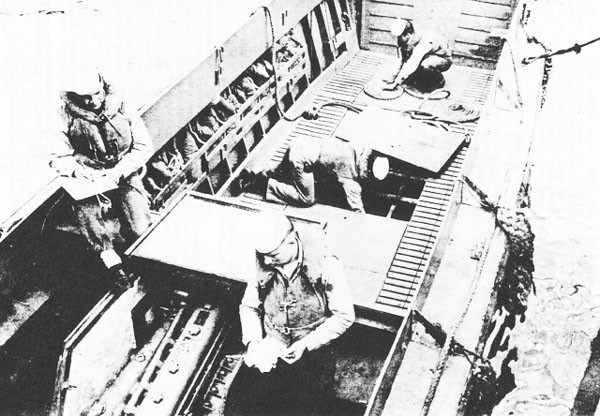
--71--
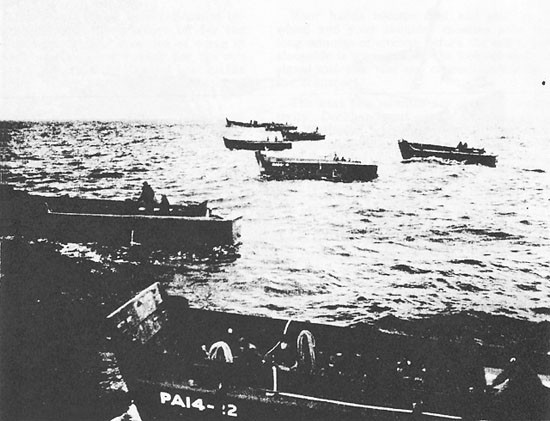
wrapped in cellophane jackets. Candy and G.I. chewing gum packaged in dull, brown paper finish off the meal.
Now the word comes to move toward the line of departure. You watch the boats selected to go in with the first wave form an open vee behind the Control Boat as it moves shoreward. Since you are in the second wave, you watch closely to see what happens so that your are sure to know what to do when it is time for your "VP" to hit the beach. In toward shore the Control Boat for your beach can be seen flying a signal flag above a solid yellow flag. This color shows that you will hit the Yellow Beach while other groups are making landing on the Red, Blue, or Green Beaches*.
As the first boat wave falls in line abreast of the Control Boat on the line of departure and begins to move shoreward you receive the signal to move in also. You fall into position and start toward the line of departure. Astern other boat waves leave the rendezvous area at stated intervals, keeping at least 50 yards apart. Spread out across the sea the landing boats are an impressive sight. Their rugged and unlovely appearance is businesslike and a little grim. In a large operation such as this one the surface of the ocean appears almost as busy as Main Street on a Saturday night. LCVP's, LCM's, LCI's, and many more large and small craft crowd the swells and dot the horizon.
You reach the line of departure and form circles with other LCVP's and LCM's. Whenever you can steal a moment you glance toward land to see how things are going.
In the meantime the first wave has moved toward shore. You can see them as tiny specks
____________
* In a landing operation the various strips of beach to be occupied are named for colors, "Red Beach", for instance, refers to the beach with red markers.
--72--
with white wakes boiling behind. Along the breaker line fast-moving boats are laying a smoke screen. The gray billows spread, blot out a large strip of land, and hide the surf close in to shore. However, Control Boats, lined up with the flanks of the beach, indicate its boundaries to the coxswains.
Now the demolition crews cut loose with explosives. Dull booms can be heard plainly and flares, bright balls of fire, zoom skyward and drive earthward trailing streamers of smoke.
About 1,000 yards from the beach the coxswains accelerate to maximum speed and the first wave swiftly approaches the breaker line. While you watch, the boats come to the line of transfer* and plow on. No signal was given by control to keep them from landing! They are going to hit the beach! Apparently the surf is not too bad.
Each boat, as it hits the surf, finds the crest of a wave and moves into the thinning smoke screen smoothly, about 75 yards from the "VP's" off its beams. For a few moments the landing boats are lost to view. Then, as the wind clears away the smoke, you see the ramps go down and troops in the mock assault pour ashore to take positions in the sand.
When the smoke has drifted completely clear it is easier to size up the landing. A seven or eight foot surf seems to be running. Breakers striking the sterns of the grounded "VP's" explode in geysers of spray. The landing has been nicely done. The boats are well-spaced between the flanks of the beach and not one has broached. Salvage boats, patrolling outside the line of surf, have received no calls as yet.
At this moment the signal is given for the second wave to drive in and support the first. Quickly you line up abreast and begin to churn through the rolling ground swells. Your "VP" is on the left flank of the wave as you approach the Yellow Beach. Crew members and troops eye the swells and wonder just how high the surf will be. They watch over the side until you remember to remind them to keep low in the boat. Life belts are checked in your "VP" as a deckhand expresses the opinion that, "It looks pretty rough in there today."
Very soon the breaker line is close ahead. You review mentally the advice of instructors: "Go in just behind the crest" . . . "Keep the breakers at right angles to your boat" . . . "Drive well up on the beach" . . . At the same time you keep one eye on the horizontal strip of yellow cloth that marks your end of the beach and the other on the boats to starboard.
Then your are in the surf. You throttle down slightly to keep just behind the crest of a large breaker and steer carefully to keep that 90° angle just right. At the same time you check to make sure that the beach ahead is clear. The crest of the breaker on which the boat rides seems to rise sharply, the sandy shore rushes near. You steal a last swift glance to starboard to see that the spacing is good. At least 75 yards separate your "VP" from the next one.
Then, with a roar, the breaker piles up on the sand. With a dull but heavy shock the boat grounds. An incoming breaker moves the hull and you gun the engine to keep well up on the sand.
Wham! A breaker strikes the boat and water showers everyone. The stern falls off slightly to port and is brought around by swinging the wheel to the left. No broach that time!
Speedily the operation progresses. The ramp goes down smoothly, the troops dash ashore. It all happens in a matter of seconds. The crew is doing the job right. Anti-broaching lines are out**, the bow man is clearing a bit of sand from the ramp, everything is under control.
The engineer cranks up the ramp. You wonder how the other coxswains are making out, but there is no time to look down the beach. You have your hands full holding the "VP" steady.
Once the anti-broaching lines are aboard you wait for the next breaker, then gun the engine in reverse when the "VP" rises free. The boat inches seaward, then settles down. A moment later the stern rises and you again twist the throttle hard. The diesel roars even more loudly than the surf and once again the landing boat edges out to sea.
With the next breaker you continue to try to pull free, but something goes wrong. The bow is turning sharply to starboard.
The breaker, a huge one, is throwing the "VP" parallel to the beach! Desperately you twist the wheel in the direction toward which the bow is moving and gun the engine in reverse. That straightens the boat, but she is back up on the beach again.
____________
* In some operations certain amphibious tracked vehicles such as DUKW's are launched or loaded at the line of transfer. The line gets its name from this transfer of cargo. In an attack on enemy-held shores the line of transfer is located beyond the range of small arms (rifle and machine gun) fire. In a training maneuver it may be close to the breaker line. The line of transfer, in training, is the last point at which landing boats may be recalled when the surf is high.
** In a training maneuver, beach party members are on hand to meet the first boat wave and handle anti-broaching lines. In an actual operation the beach party goes ashore with the third and following waves.
--73--
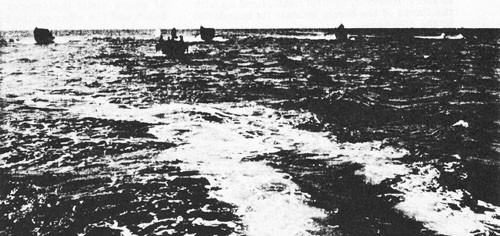
"Easy does it," the engineer shouts to encourage you. "Here's a high one coming! Get ready to give her the gun!"
The "high one" is really big! You barely have time to set your rudder amidships before the boat rises clear and moves seaward rapidly while you hold the throttle open. You're off the beach. Another breaker pounds the stern but the crucial moment is past. The "VP" is retracting smoothly and the situation is well in hand.
For the first time there is a moment to glance at the beach. Two boats are broached, you notice, and feel a glow of pleasure because your boat is passing the surf line safely. As a swell passes beneath the keel you swing the bow to port and make for the nearer flank of the Yellow Beach to get clear of the third wave of LCM's and LCVP's.
Now that your part in the assault phase of the maneuver is over the boat is headed back to the transport area. Here the boats lie to until it is time for them to participate in the cargo phase of the mock attack. During the cargo phase the LCVP's and LCM's are loaded with the many kinds of gear and supplies required by men securing a beach-head. These include: fuel, ammunition, vehicles, heavy guns, rations, fresh water, medical supplies, and many more. Once loaded, each boat is given a flag which indicates the kind of handling required by the cargo carried. This helps the officer directing boat traffic to get each LCVP or tank lighter to the right spot on the beach at the right time.
Before the boats run through the surf carrying cargo, a Secondary Control boat lies off each of the beaches at a safe distance and establishes radio communications with the Beachmaster. When you take your LCVP alongside the transport for a load of cargo, you will receive a cargo ticket* which lists the gear or equipment put in your cargo space. With this ticket you steer to the secondary Control boat, go alongside, and hand it over to the officer directing traffic. He keeps the ticket and directs you either to port or starboard of his boat where you will circle until ordered to the beach. As calls for various kinds of equipment or supplies are received from shore the officer on the Secondary Control boat refers to a sheet on which various cargoes described on the cargo ticket have been listed. He then selects an LCVP or a tank lighter loaded with the supplies needed ashore and directs this boat to land.
___________
* The coxswain is given four copies of the cargo ticket. One is handed to the Control Boat Officer and two to the Beachmaster or his representative. The coxswain keeps the fourth copy.
--74--
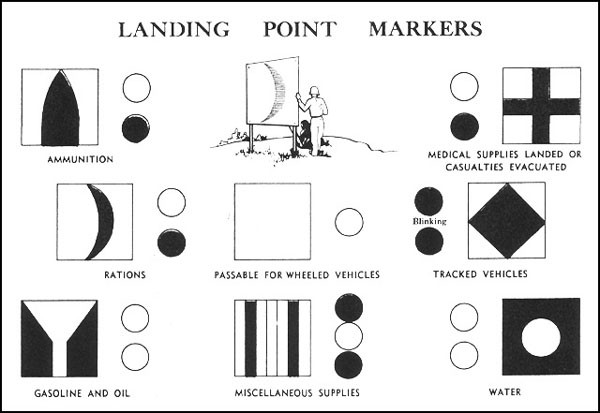
Suppose that your LCVP is carrying a load of gasoline and oil*. When a request for fuel is received the officer on the Secondary Control boat will instruct you to beach near the landing point marker which indicates a gasoline and oil dump. (The color illustration shows the landing point markers now in use).
Once again you drive ashore and unload near the marker painted to look like a yellow funnel, retract, and return to the transport area by way of the nearer flank of the beach. In a training maneuver one trip with cargo usually is all that is made.
Once you reach the transport area you fall into a circle and wait until the training maneuver is ended. When all boats are accounted for they peel off one by one in column formation and head back to the docks from which they came. Usually it is late in the afternoon. You and the other crew members are tired and there is little talking. Nevertheless, you feel mighty satisfied with a day's work well done. It wasn't too bad, that run through the surf. You know what the score is now. Next time the job will be easier. It is worth a few tired muscles to have that feeling!
____________
* In training, such cargo is usually simulated or imaginary.
--75--
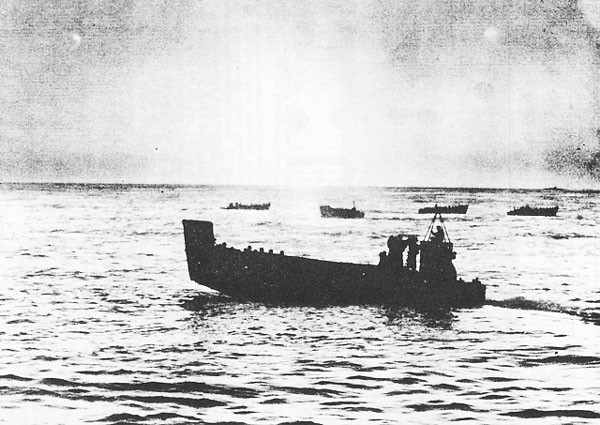
--76--
[End of Chapter 10]



